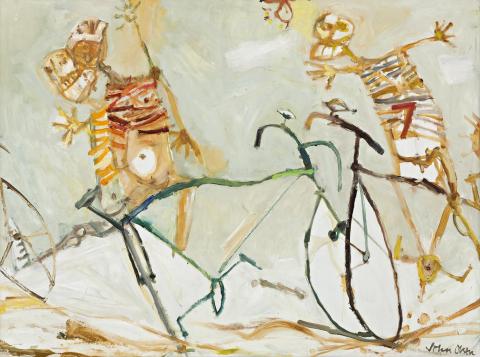THE BICYCLE BOY’S COLLISION, 1961
JOHN OLSEN
oil on composition board
76.0 x 101.5 cm
signed lower right: John Olsen
John Landau, Melbourne
Private collection, Melbourne
Private collection, Perth
Spate, V., John Olsen, Georgian House, Melbourne, 1963, p. 18
The Bicycle Boys, 1955, oil on canvas, 92.5 x 77.2 cm, in the collection of the National Gallery of Australia, Canberra, illus. in Art and Australia, Sam Ure Smith and The Fine Arts Press, Sydney, vol. 14, No. 3 – 4, Summer 1977, p. 340
The Bicycle Boys Collision, 1955, oil on canvas, 60.0 x 75.5 cm, formerly in the collection of James O. Fairfax AC, New South Wales, illus. in Hurlston, D., and Edwards, D. (eds.), John Olsen: The You Beaut Country, National Gallery of Victoria, Melbourne, 2016, p. 40
Robert Hughes was the most acclaimed art critic Australia has ever produced yet he was happy to state publicly that ‘everything I know about painting, I learned in John Olsen’s old Victoria Street studio in Kings Cross’.1 Having returned from a revelatory period in Spain, Olsen took up residence on the edge of the Kings Cross cliff in 1960 in a rambling terrace house with views directly over the sprawling streets of working-class Woolloomooloo and the harbour beyond. The suburb was already an artists’ hub and nearby studios housed William Rose, Stanislav Rapotec, Bernard Hesling and others. It was also here that Olsen developed the sensational ‘You Beaut Country’ series which transformed Australia’s landscape tradition and signaled a new way of interpreting life itself. In his meandering lines and calligraphic splashes, Olsen’s paintings sought to depict the experience of an actual walk through the streets, including chance encounters with locals, barking dogs and incidents as he witnessed them; and The Bicycle Boy’s Collision, 1961 is an extension of this process.
Three bikes are involved in this crash, and the figure on the right wears a jersey bearing the number ‘7’, indicating this was an actual race and heightening the drama of the image. It is also a reworking of a celebrated earlier painting, The Bicycle Boys Rejoice, 1955 which was a feature of the renowned James Fairfax AO Collection (Deutscher and Hackett, 30 August 2017, lot 7). This work clearly showed the influence of the artist’s teacher John Passmore who was a devotee of Cezanne, and of Olsen’s own admiration for the Swiss painter Paul Klee, as noted by Olsen’s first biographer Virginia Spate: ‘Here Klee’s wit is transformed into Rabelasian laughter. Yet for all its laughter, one recognises that the painting is a serious thing. It is orgiastic rather than humorous. … a wild joy (with) an intensity that disturbs and threatens’.2 Spate also identified that this earlier painting displayed ‘the beginning of the linearism which is … Olsen’s most expressive quality’.3 During his overseas sojourn, the young artist saw Cézanne’s work in the flesh for the first time and recognised that the Frenchman’s process could never fully capture the dynamism he wished to portray. Exposure to the materially impoverished but spiritually rich communities in Spain was a further revelation, as was Olsen’s viewing of examples of international contemporary abstraction. Additionally, he was already an admirer of Aboriginal art, ‘the striations and dots, as well as the handprints imbedded in the landscape’,4 and on his return to Australia, sought to amalgamate these sources to capture the pulsating sprit of the Australian experience.
The Bicycle Boy’s Collision is an unashamedly ‘vulgar’ painting with echoes of doodles, graffiti and children’s art, but Olsen has utilised these influences ‘with a power, persistence and penetration that is quite outside the capacity of immature, inattentive or incapable minds. … It is art with its guards down – spontaneous and completely personal’.5 The bicyclists seem caught between grimace and exultation, set in a flatly defined space of broad brush-marks deliberately lacking a third dimension. Angles, lines and colours create repeat sequences such as where the pedals of the rider to the right mimic the outstretched arms above them; and the eye roams around the chaos in a similarly jagged manner.
1. Hughes, R., quoted on back cover of Olsen, J., Drawn from Life, Duffy and Snellgrove, Sydney, 1997
2. Spate, V., Australian Art Monographs: John Olsen, Georgian House, Melbourne, 1963, pp. 12 – 13
3. Spate, V., op cit., p. 4
4. Hart, D., John Olsen, Craftsman House, Sydney, second edition, 2000, p. 59
5. Gleeson, J., ‘Why Not Picture on the Ceiling?’, The Sun-Herald, Sydney, 25 November 1962, p. 53
ANDREW GAYNOR
